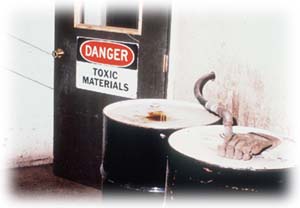Woodworking eTool
Finishing/Chemicals » General Hazards/Solutions
Finishing operations pose a wide range of health and safety hazards due to the volume and physical properties of the chemicals involved. A complete discussion of this topic is beyond the scope of this eTool; however, a general discussion of common hazards and related control measures are provided.
To best protect employees from the chemical hazards related to finishing operations, identify the specific chemicals in use within the facility and consult the appropriate OSHA standards to determine required controls. See the additional references section of this eTool for a list of the OSHA standards likely to apply to finishing operations.

-
>> General Hazards/Solutions
Potential Health Hazards
-
A wide range of adhesives and coating agents are used in finishing wood products. Many of these are hazardous to the employees' health.
Chemicals can enter the body in three ways: through inhalation (breathing), ingestion (eating), or contact with the skin. The skin readily absorbs many chemicals such as solvents, allowing them to enter the bloodstream. Woodworkers generally are exposed to chemicals through inhalation and contact with the skin.
Both nitrocellulose topcoats (lacquers) and acid-catalyzed coatings (conversion varnishes) contain solvents that are toxic to humans. The solvents most commonly used in these coatings include toluene, xylenes, methyl ethyl ketone (MEK), methyl isobutyl ketone (MIBK), and methanol. The acid-catalyzed coatings contain formaldehyde. All of these solvents have short-term effects such as irritation of the eyes, nose, and throat, headaches, dizziness, confusion, fatigue, and nausea. The longer-term effects include reproductive problems, central nervous system disorders, and damage to the lungs, liver, and kidneys.
Many of the adhesives used in finishing wood products also contain toxic chemicals. The most hazardous are the solvent-based, epoxy resin, and urea-formaldehyde resin adhesives. Many of the solvents used in the coating agents are used in the adhesives. The epoxy resin adhesives are particularly toxic. Methylene chloride, which has been shown to cause cancer in laboratory animals, often is the base for these adhesives. Some of the components of the epoxy resins also may be cancer-causing. Epoxy resin adhesives also can cause dermatitis and a sensitization reaction.
Potential Safety Hazards
-
In addition to the health hazards posed by the chemicals used in finishing operations, many of the solvents, lacquers, varnishes, and coatings used in these operations are extremely flammable. These materials can pose significant fire and explosion hazards if used in large quantities, in unventilated or enclosed areas, or in processes such as spray finishing operations that can lead to significant airborne concentrations of the material.
Possible Solutions
Engineering Controls
-
When feasible, use automated systems for applying coatings and adhesives. Automated systems should be ventilated.
-
Substitute the traditional solvent-based coatings and adhesives with coatings and adhesives that are less toxic. Hot melt, heat seal, aqueous-based, and polyvinyl acetate adhesives are good, less-toxic alternatives to solvent-based adhesives. Higher-solids nitrocellulose, aqueous-based, ultraviolet-cured, and polyester/polyurethane coatings also are less toxic than solvent-based coatings.
-
Provide adequate local exhaust ventilation for all coating and gluing processes. This includes manual spraying, rolling, and brushing operations, automated coating processes, and dip coating. Manual spray operations should be performed in a spray booth or a separate, ventilated spray area. Dip coating should be ventilated with an enclosure or capture hood. Consult the OSHA standard on dip coating (open surface tanks), 29 CFR 1910.122-126, for detailed requirements on dipping operations.
-
The OSHA standard for spray finishing operations, 29 CFR 1910.107, provides detailed requirements for the design and construction of spray booths and rooms, air filters, velocity and air flow requirements, and the (make-up) air supplied to the booth. It is important to maintain the proper air flow in a spray booth. Excessive air pressure decreases the efficiency of the operation, wastes material, and may cause a backlash of vapors and overspray into adjacent work areas. Dirty air filters can decrease the air flow in the booth. Ensure that filters are cleaned and replaced as needed. Although these provisions are designed to prevent the occurrence of a fire or explosion in spray finishing operations, they also assist in protecting workers from the health hazards of the chemicals used in the operation by removing the chemicals from the atmosphere.
-
Employers shall provide employees with effective information and training on hazardous chemicals. 29 CFR 1910.1200(h)(1)
Controls designed to prevent fire and explosion resulting from the use of flammable and combustible materials in woodworking operations are discussed in the Fire and Explosion section of this eTool. The controls discussed in this section generally are also applicable to finishing operations.

